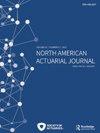Backcasting Mortality in England and Wales, 1600–1840
IF 1.6
Q3 BUSINESS, FINANCE
引用次数: 0
Abstract
There have been significant developments in using extrapolative stochastic models for mortality forecasting (forward projection) in the literature. However, little attention has been devoted to mortality backcasting (backward projection). This article proposes a simple mortality backcasting framework that can be used in practice. Research and analysis of English demography in the 17th and 18th centuries have suffered from a lack of mortality data. We attempt to alleviate this problem by developing a technique that runs backward in time and produces estimates of mortality data before the time at which such data became available. After confirming the time reversibility of the mortality data, we compare the backcasting performance of some commonly used stochastic mortality models for the England and Wales data. The original Lee–Carter model is selected for backcasting purpose of this dataset. Finally, we examine the longevity of British artists between the 17th and the 20th centuries using the backcasted population mortality as benchmarks. The results show that artists living in Britain from 1600 to the mid 1800s had life expectancies similar to those of the general population, with a marked increase in longevity after the Industrial Revolution.英格兰和威尔士1600–1840年的回溯死亡率
文献中使用外推随机模型进行死亡率预测(正向预测)有了重大进展。然而,很少有人关注死亡率的反向预测(反向预测)。本文提出了一个简单的死亡率回溯框架,可以在实践中使用。对17世纪和18世纪英国人口学的研究和分析一直缺乏死亡率数据。我们试图通过开发一种技术来缓解这个问题,该技术在时间上向后运行,并在这些数据可用之前产生死亡率数据的估计值。在确认了死亡率数据的时间可逆性后,我们比较了一些常用的随机死亡率模型对英格兰和威尔士数据的回溯性能。选择原始的Lee–Carter模型用于该数据集的回溯目的。最后,我们以人口死亡率为基准,考察了17世纪至20世纪英国艺术家的寿命。研究结果显示,1600年至19世纪中期生活在英国的艺术家的预期寿命与普通人相似,工业革命后,他们的寿命显著延长。
本文章由计算机程序翻译,如有差异,请以英文原文为准。
求助全文
约1分钟内获得全文
求助全文

 求助内容:
求助内容: 应助结果提醒方式:
应助结果提醒方式:


